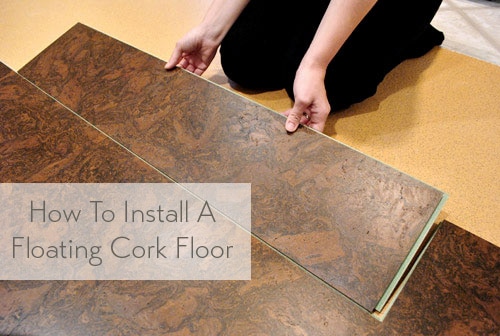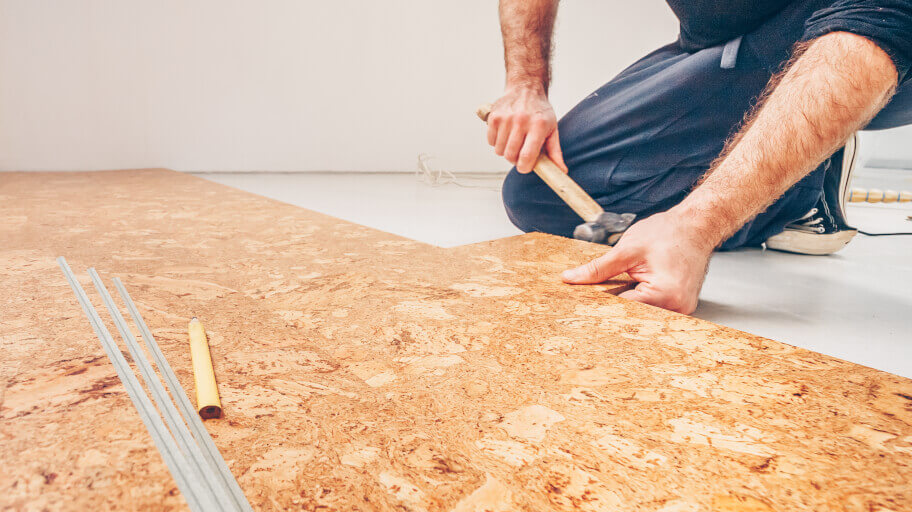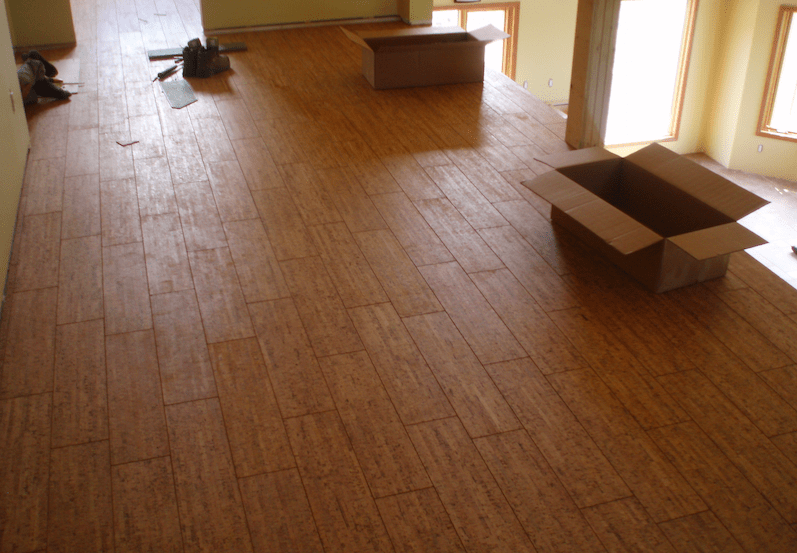Preparing Your Subfloor for Cork Tile Installation
Before diving into cork flooring installation, one of the most crucial steps is preparing the subfloor. In my experience, taking the time to ensure that your subfloor is in good condition will save you from potential issues down the line. A properly prepared subfloor creates a smooth, even surface for the cork tiles to adhere to, ensuring they stay in place for years to come.
- Cleaning and Clearing the Area: The first step in subfloor preparation is clearing the area of any obstacles and debris. I always recommend sweeping and vacuuming the floor thoroughly to remove dust, dirt, and any small particles. Cork tiles need a smooth surface to adhere to, so even a tiny piece of debris could cause bumps or irregularities. Once everything is clean, check for any moisture on the subfloor, as the cork is sensitive to water.
- Assessing the Subfloor Material: One thing I’ve learned over the years is that the type of subfloor you’re working with matters. Cork flooring can be installed over a variety of subfloors, including concrete, plywood, and even existing vinyl or tile. However, the subfloor must be flat, dry, and smooth. If you’re working with a concrete subfloor, for example, you’ll need to check for moisture using a moisture meter and potentially apply a moisture barrier.
- Repairing Cracks or Holes: If there are any cracks, holes, or imperfections in your subfloor, now is the time to fix them. For concrete subfloors, I use a concrete patch compound to fill in any cracks or holes. On plywood, wood filler works well to smooth out imperfections. These repairs ensure that the cork tiles will sit flush against the floor, preventing unevenness.
- Sanding Uneven Areas: In cases where the subfloor is slightly uneven, I’ve found that sanding can make a huge difference. Use a hand sander or floor sander to even out any high spots. This step is particularly important for plywood subfloors, as cork tiles need a completely flat surface for proper adhesion. After sanding, vacuum the area again to remove any dust or debris.
- Checking for Moisture: As I mentioned earlier, moisture is cork’s worst enemy. Whether you’re working with a concrete or wooden subfloor, make sure it’s dry before you proceed. I recommend using a moisture meter to check the subfloor’s moisture levels. If the levels are too high, consider applying a moisture barrier or allowing the subfloor to dry out before continuing with the installation.
- Priming the Subfloor: Finally, for certain subfloors like concrete, applying a primer can help the adhesive bond better. I usually apply a coat of primer and let it dry completely before proceeding with the next steps. This extra layer of preparation ensures that the adhesive will bond securely, giving your cork tiles a long-lasting hold.
Gathering the Essential Tools and Materials
Before you start installing cork flooring tiles, it’s important to gather all the necessary tools and materials. Trust me, having everything ready beforehand will save you a lot of hassle and interruptions during the installation process. In my experience, a well-prepared workspace leads to smoother, faster, and more efficient work.
Cork Tiles
The first and most obvious material you’ll need is the cork tiles themselves. When choosing your cork tiles, make sure to get enough to cover your entire floor, plus a little extra for any mistakes or future repairs. I always recommend purchasing 10% more tiles than you think you’ll need, just in case. Cork tiles come in different finishes, so make sure you’ve chosen the right style for your space.
Adhesive
Cork tiles require a strong adhesive to keep them in place. I usually use water-based contact cement or cork adhesive, which is designed specifically for cork flooring. Make sure you follow the manufacturer’s guidelines for the adhesive you choose, as some may require longer drying times or specific application methods.
Measuring Tape and Ruler
Accurate measurements are key when installing cork tiles, so a good measuring tape is essential. I like to use a long measuring tape for large areas and a ruler or straight edge for more precise cuts. Having both on hand will help you measure your space accurately and ensure the tiles are laid out correctly.
Utility Knife and Cutting Board
Cork tiles are relatively easy to cut, but you’ll still need a sharp utility knife to trim them to size, especially around corners and edges. I always make sure to use a fresh blade to get clean, smooth cuts. A cutting board or protective surface is also helpful to avoid damaging your floors or work surfaces while cutting the tiles.
Trowel
A trowel is used to spread the adhesive evenly across the subfloor. Depending on the type of adhesive you’re using, you may need a specific type of trowel, such as a notched trowel, to create grooves in the adhesive. I recommend checking the adhesive instructions for the recommended trowel size to ensure proper application.
Rubber Mallet and Roller
After laying the cork tiles, you’ll need to press them firmly into the adhesive. I like to use a rubber mallet to tap the tiles into place without damaging them. A roller, either a hand roller or a floor roller, is also helpful for pressing the tiles down evenly and ensuring they adhere properly. This step helps eliminate any air bubbles and creates a strong bond between the tiles and the subfloor.
Measuring and Planning the Layout for Cork Tiles
Proper planning is key to any successful flooring project, and cork tiles are no exception. Before you start laying down tiles, I always recommend taking the time to measure and plan the layout of your floor. In my experience, a well-thought-out layout not only ensures a professional finish but also prevents mistakes that could cost you time and materials.
Measuring the Room Dimensions
The first step in planning your layout is measuring the room. I always start by measuring the length and width of the space to get the total square footage. Once you know the size of the room, you can determine how many cork tiles you’ll need. Remember to include extra tiles to account for mistakes and future repairs, typically around 10% more than the exact measurement.
Marking a Starting Point
One of the most important steps is deciding where to start laying the tiles. I usually start from the center of the room and work outward, as this helps ensure that the tiles are evenly distributed and look symmetrical. To find the center, I measure and mark the midpoint of each wall, then draw chalk lines between the points to create a cross. The point where the lines intersect is the center of the room, and it’s from this point that I’ll begin laying the tiles.
Dry-Laying the Tiles
Before applying any adhesive, I always dry-lay a few rows of tiles to see how the layout will look. This gives me a chance to make adjustments and ensure that the tiles are spaced evenly and the pattern looks right. I find this step incredibly helpful, as it lets me see if any tiles will need to be cut, and it gives me a visual sense of how the finished floor will look.
Considering Tile Patterns
When it comes to laying cork tiles, there are a few different patterns you can choose from. I typically recommend a straight pattern for a clean, modern look, but a staggered or diagonal pattern can add interest and create a unique design. If you’re going for a specific pattern, now is the time to plan it out and make sure the tiles are arranged accordingly.
Ensuring Even Gaps
I always make sure to leave small gaps around the edges of the room to allow for expansion, especially in areas with temperature or humidity fluctuations. Cork is a natural material that can expand and contract, so leaving a small gap around the perimeter of the room prevents the tiles from buckling or shifting over time. You can use spacers to ensure even gaps along the walls.
Double-Checking Measurements
Once everything is laid out and ready to go, I take one last measurement to ensure accuracy. I’ve found that double-checking the room dimensions, tile sizes, and layout before applying adhesive can save a lot of headaches later on. If everything looks good, it’s time to move on to the actual installation process.
Applying Adhesive for a Secure Cork Tile Installation
Once the subfloor is prepared and the layout is planned, the next step is applying adhesive for the cork tiles. In my experience, applying the adhesive correctly is crucial to ensuring that the tiles stay in place and don’t shift over time. Here’s how I go about applying the adhesive in a way that guarantees a strong, secure installation.
Choosing the Right Adhesive
The first thing to consider is the type of adhesive you’ll be using. I usually opt for water-based contact cement or a cork-specific adhesive, as these are designed to work well with cork tiles. Make sure to check the manufacturer’s recommendations for your specific cork tiles, as different brands may require different adhesives. It’s important to use the right adhesive to ensure a strong bond that will hold up over time.
Applying Adhesive to the Subfloor
When it comes to applying the adhesive, I always follow a step-by-step approach. Using a notched trowel, I spread a thin, even layer of adhesive over a small section of the subfloor. I prefer to work in sections, as cork adhesive tends to dry quickly. I find that spreading adhesive over a large area can lead to rushed installation, which increases the chances of mistakes.
Letting the Adhesive Set
After applying the adhesive, I allow it to set according to the manufacturer’s instructions. Typically, cork adhesives require a few minutes to become tacky before the tiles are laid down. It’s important not to rush this step, as laying the tiles too soon can cause them to slip or move around, which affects the overall appearance and durability of the floor.
Applying Adhesive to the Cork Tiles
In some cases, the adhesive may also need to be applied to the back of the cork tiles. When this is required, I spread a thin, even layer of adhesive on each tile and allow it to become tacky before placing it on the floor. This ensures a strong, secure bond between the tile and the subfloor. Be sure to check the adhesive instructions to see if this step is necessary for your specific product.
Ensuring Even Adhesive Coverage
One of the most important things to keep in mind is even adhesive coverage. I always make sure that there are no gaps or dry spots in the adhesive, as this can cause the tiles to lift or shift over time. Using a notched trowel helps create an even layer and ensures that the tiles will adhere securely to the subfloor. It’s better to apply a little extra adhesive than to risk having tiles that aren’t properly secured.
Cleaning Excess Adhesive
As I lay down the tiles, I keep a damp cloth on hand to wipe away any excess adhesive that may seep through the gaps between the tiles. This step is crucial, as dried adhesive can be difficult to remove and may affect the appearance of the finished floor. By cleaning up adhesive as I go, I ensure a clean, professional-looking installation.
Laying Cork Tiles: Step-by-Step Guide
Now that the adhesive is applied, it’s time for the fun part—laying the cork tiles. This is where the floor really starts to come together. I always take my time during this step, as careful tile placement is key to achieving a professional-looking finish. Here’s how I go about laying cork tiles, step by step.
Starting at the Center
As I mentioned earlier, I like to start laying the tiles from the center of the room and work my way outwards. This ensures that the tiles are evenly distributed and the pattern looks symmetrical. Starting from the center also helps prevent uneven tiles or awkward cuts along the edges of the room.
Pressing Tiles into Place
Once I’ve positioned the first tile, I press it firmly into the adhesive. I use a rubber mallet to gently tap the tile into place, ensuring that it adheres securely to the subfloor. I always make sure to apply even pressure across the entire tile to avoid air bubbles or gaps. If you’re working with large tiles, a floor roller can also help press the tiles down evenly.
Laying the Next Rows
After the first tile is in place, I continue laying the tiles in rows, following the layout I planned earlier. I always leave a small gap between the tiles and the walls to allow for expansion. It’s important to work carefully and methodically, making sure that each tile is aligned with the previous one to maintain a straight, even pattern.
Checking for Alignment
As I lay each row of tiles, I periodically check to make sure that everything is aligned properly. I find that using a straight edge or a level can help ensure that the tiles are laid in a straight line. If I notice any tiles that are slightly out of place, I adjust them before the adhesive sets. This attention to detail ensures a smooth, professional finish.
Allowing for Expansion
Cork is a natural material that can expand and contract with changes in temperature and humidity. To account for this, I always leave a small expansion gap around the edges of the room, usually about 1/4 inch. This gap can be covered with baseboards or trim later on, so it won’t be visible on the finished floor. It’s a small step that makes a big difference in the long-term performance of the floor.
Letting the Tiles Set
Once all the tiles are in place, I let them sit undisturbed for at least 24 hours to allow the adhesive to fully cure. During this time, it’s important not to walk on the floor or place any furniture on it, as this can cause the tiles to shift. After the adhesive has fully cured, the floor is ready for the final finishing touches.
Trimming and Cutting Cork Tiles for a Perfect Fit
When installing cork tiles, one of the final steps involves trimming and cutting tiles to fit around the edges of the room, as well as around obstacles like doorways, pipes, or fixtures. In my experience, careful cutting and trimming is essential for achieving a seamless, professional finish.
Measuring for Cuts
The first step in cutting cork tiles is measuring the area where the tiles will need to be trimmed. I always use a measuring tape to get the exact dimensions, making sure to leave a small expansion gap between the tile and the wall or obstacle. It’s important to double-check your measurements before cutting, as cork tiles can be difficult to replace if you make a mistake.
Marking the Tiles
Once I have the measurements, I mark the tiles using a pencil or chalk. I usually mark the back of the tile to avoid leaving visible marks on the finished surface. It’s important to be as precise as possible when marking the tiles, as this will ensure a clean, accurate cut.
Cutting the Tiles
To cut the tiles, I use a sharp utility knife with a fresh blade. I find that scoring the tile several times along the marked line makes it easier to get a clean, smooth cut. For larger cuts or more complex shapes, I sometimes use a jigsaw or a tile cutter. Just make sure to cut slowly and carefully to avoid chipping or damaging the cork.
Fitting the Tiles
After cutting the tiles, I test-fit them in place to make sure they fit properly. If the tile is slightly too large, I trim a little more until it fits snugly. It’s important to check for gaps and ensure that the tile fits securely against the adjacent tiles without leaving any visible seams.
Installing the Trimmed Tiles
Once the tile is cut to size and fits perfectly, I apply adhesive to the back of the tile and press it into place. I always make sure to press firmly and use a rubber mallet to tap the tile down, just like with the full-sized tiles. This ensures that the trimmed tiles adhere securely and blend in seamlessly with the rest of the floor.
Cutting Around Obstacles
Cutting tiles to fit around obstacles like door frames, pipes, or fixtures can be a bit tricky, but with the right tools and patience, it’s doable. I always take my time to carefully measure and mark the tile, then use a utility knife or jigsaw to cut out the shape. A snug fit around obstacles gives the floor a polished, professional look.
Finishing and Sealing Your Cork Floor for Durability
After all the tiles are installed and trimmed to fit, the final step in the cork flooring installation process is sealing the floor. In my experience, sealing is essential for protecting the cork tiles and ensuring they last for years to come. Cork is a natural material, and sealing helps protect it from moisture, stains, and wear.
Choosing the Right Sealer
The first step in sealing your cork floor is choosing the right sealer. I usually recommend a water-based polyurethane sealer, as it provides excellent protection without altering the natural color of the cork. There are also oil-based sealers available, but these can give the cork a slightly yellow tint. Make sure to choose a sealer that is specifically designed for cork flooring to get the best results.
Applying the First Coat of Sealer
To apply the sealer, I use a foam brush or a paint roller with a short nap. I always start by applying a thin, even coat of sealer across the entire floor, working in small sections to ensure complete coverage. It’s important to avoid applying too much sealer at once, as this can lead to drips or an uneven finish. I also make sure to follow the grain of the cork to get a smooth, consistent finish.
Letting the Sealer Dry
After applying the first coat of sealer, I let it dry completely before applying additional coats. Depending on the type of sealer you’re using, this can take anywhere from a few hours to overnight. It’s important to let the sealer dry fully before walking on the floor or applying additional coats, as premature foot traffic can cause the finish to become uneven.
Sanding Between Coats
Once the first coat of sealer is dry, I lightly sand the surface with fine-grit sandpaper. This step helps smooth out any imperfections and creates a better bond between coats. After sanding, I vacuum the floor and wipe it down with a damp cloth to remove any dust or debris before applying the next coat of sealer.
Applying Additional Coats of Sealer
For maximum durability, I usually recommend applying at least two or three coats of sealer. Each additional coat provides added protection and enhances the appearance of the cork. Just like with the first coat, I apply each additional coat evenly and let it dry fully before sanding and applying the next coat. The result is a smooth, durable finish that will protect the cork for years to come.
Allowing the Floor to Cure
After the final coat of sealer is applied, it’s important to let the floor cure for at least 48 hours before placing furniture or walking on it. This allows the sealer to fully harden and provides maximum protection. Once the floor is fully cured, it’s ready for use, and you can enjoy the beauty and durability of your new cork flooring.
How to Install Cork Tile Flooring (DIY) Family Handyman
How To Install A Floating Cork Floor Young House Love
Cork Flooring Guide – Specifics, Pros & Cons, Price Fantastic
Cork Flooring Installation – How to Do It DIY Home Improvement
How To Install A Floating Cork Floor Young House Love Cork
Related Posts:










